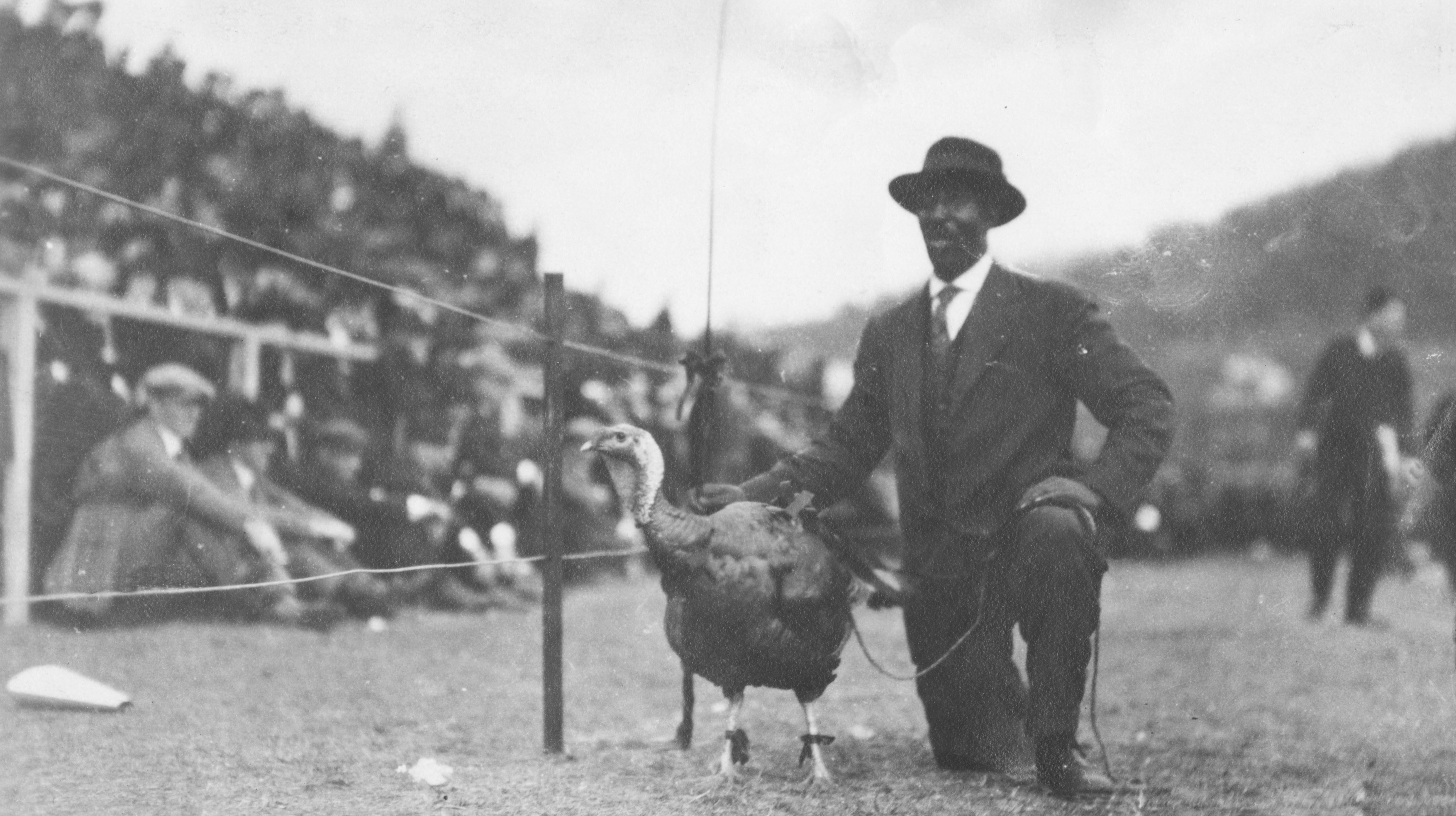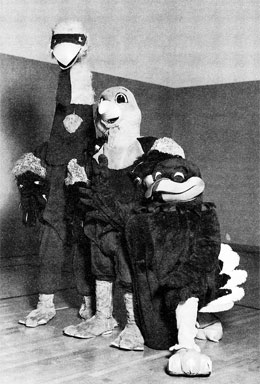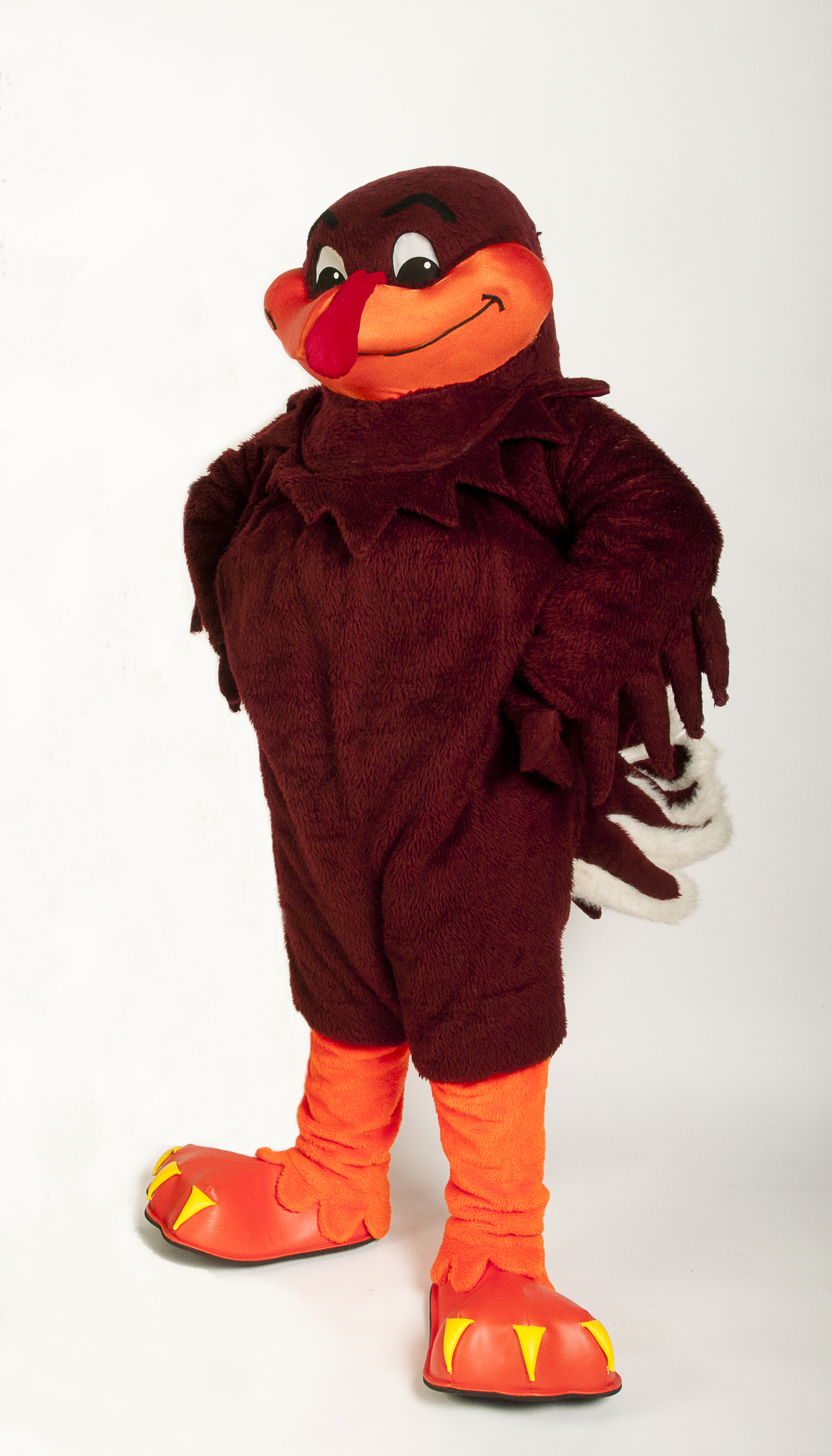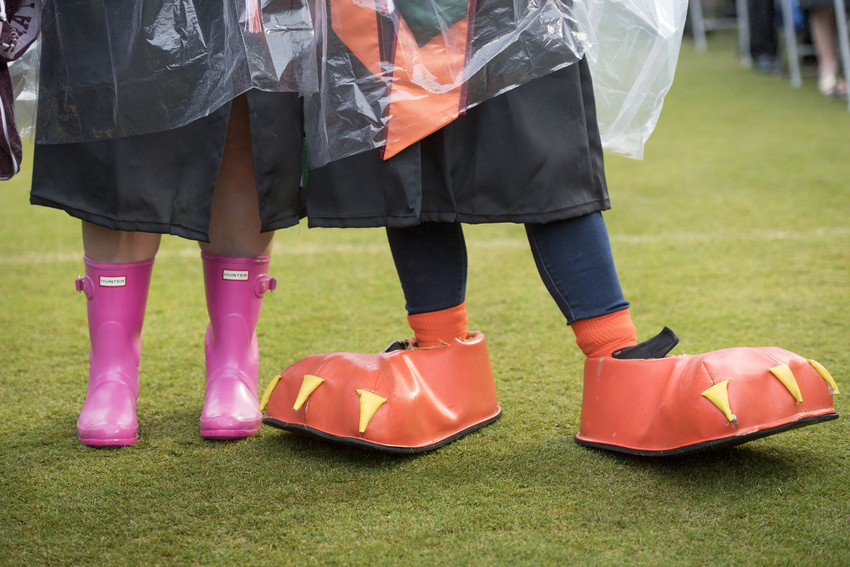Mascots and Nicknames
Nicknames
Hokies: When the General Assembly changed the VAMC name to Virginia Agricultural and Mechanical College and Polytechnic Institute, the college needed a new cheer.
The old one had been a simple play on the college’s name:
Rip, Rah, Ree!
Va, Va, Vee!
Virginia, Virginia!
A-M-C!
The college, whose name was shortened in popular usage to Virginia Polytechnic Institute, or, simply, VPI, held a contest for the student body to come up with a new spirit yell. The cheer entered by O. M. (Oscar Meade) Stull, a member of the class of 1896, won the $5 prize for first place. Like the old cheer, the new one was also a play on the college’s name:
Hoki, Hoki, Hoki, Hy!
Techs, Techs, V.P.I.!
Sola-Rex, Sola-Rah.
Polytechs – Vir-gin-i-a.!
Rae, Ri, V.P.I.!
By 1903, an “e” had been added to “Hoki,” either for looks or to forestall mispronunciation of the word that Stull said he created merely as an attention-grabber in the cheer, which became known as “Old Hokie.” ”Team! Team! Team!” was later added at the end of the cheer.
Gobblers: Another nickname, which did not exist when Stull wrote his cheer, became more popular than Hokies. Fans used the nickname “Gobblers,” beginning in the early 20th century, more than “Hokies”—at least until the 1980s.
Disagreements exist about how the nickname “Gobblers” originated. One idea for its origination is that the “Gobblers” tag developed when a small group of cadets attended the 1907 Thanksgiving Day football game in Richmond, which pitted VPI against the University of North Carolina. The students returned to campus to spread the word that their victorious team “took the turkey.”
Another possibility is that the name developed from the eating habits of athletes, who “gobbled” their food. Taylor Adams, class of 1909, wrote that the name “was first applied to the members of the football squad because of their gargantuan appetites. . . . The excess avoiddupois of these Neanderthals . . . was sustained by bigger and better feeding of ‘growley’ [the cadets’ term for food] than were given to the lowly proletarians of the corps. . . . They fed, I remember, with the voracity of barracuda at special so-called ‘training tables.’ Their gobblings of food were legendary and naturally gave rise to their unfortunate pseudonym.”
Harry Temple in The Bugle’s Echo says that in 1909 cadets would start yelling “coni-a-ah” as an inspirational cry when the team was in a tight spot and football players would respond with a turkey gobble call.
Another possible source is that the nickname developed in 1909, when football Coach Branch Bocock pulled his players aside, one by one, and initiated them into an impromptu and informal “Gobbler Club” to build team spirit and camaraderie. After that, the name took off, appearing in print for the first time that same year.
In the late 1970s, the university hired Bill Dooley as football coach and athletic director. Dooley eventually heard that the Gobblers moniker evolved from the eating habits of athletes. Not liking the image, he took steps in the early 1980s to ensure that Virginia Tech’s prominent nickname became Hokies rather than Gobblers—he even removed the turkey-gobble sound from the scoreboard.
Frank Beamer, who had played on the Gobbler football team in the 1960s, put the gobble back on the scoreboard when he became football coach in 1987. But by then the Hokies nickname had stuck—even though Lane Stadium still erupts in cheers when the scoreboard emits the turkey gobble.
Mascot
Virginia Tech’s HokieBird mascot has quite a history, which intertwines the two nicknames.

In the early 1900s, the official mascot was a VPI employee who had become a favorite of the cadets—and his special designation as mascot extended to his turkey, which eventually usurped his position. The Gobbler nickname had already become popular when—and no doubt was the reason why—Floyd “Hard Times” Meade, a local resident and VPI employee chosen by the student body to serve as the school’s mascot, trained a large turkey to perform various stunts. Meade first demonstrated his turkey’s skill—and strength—at a football game in 1913 by having the turkey pull a cart with Meade riding in it. But college President Jospeh D. Eggleston Jr. thought the cart-pulling was cruel to the turkey and halted it after one game. After that, Meade only paraded the turkey, which he had trained to gobble on command, up and down the sidelines—and did so until another turkey trainer, William Byrd “Joe Chesty” Price, took over in 1924. Use of a live turkey mascot on the sidelines continued at least until Price’s retirement in 1953 and possibly into the early 1960s.
While a costumed Gobbler joined the live turkey for at least one game in 1936, the first permanent costumed Gobbler did not appear until the fall of 1962. In the early 1960s, Mercer MacPherson, a civil engineering student, saw the mascot for another university and decided that VPI should have one as well. He contacted a manufacturer, learned what a mascot suit would cost, and raised the money, most of it from civilian students.
Money in hand—$200—MacPherson drove to the manufacturing company, located in Pittsburgh, to help create the costume. The result was a somewhat unusual turkey with a cardinal-like head. It sported real turkey feathers dyed in school colors.
The costume arrived a few days before the last football game of the season, what was then the annual Thanksgiving Day face-off between VPI and VMI in the “Military Classic of the South.” MacPherson donned the get-up to become the first of Virginia Tech’s permanent—though visually evolving—mascots.
Even though the mascot was known as the Gobbler and then the Fighting Gobbler for 20 years, the costume itself underwent at least one major alteration. In 1971 it was modified to a long-necked bird—some 7 1/2 feet tall. The name was modified as well—to Fighting Gobbler—on the suggestion of the football coach at the time.
The long-necked bird was used for 10 years before Dooley began pushing to eliminate the Gobbler image. In 1981 the Athletic Department contacted the art department about assigning a student to sketch designs for a new mascot costume. Student George Wills accepted the assignment and drew several designs for his class project. The designs went to a company in Cleveland that stitched together the final costume based on those drawings.

The new mascot made its first appearance in September 1981 at the Virginia Tech – Wake Forest football game, arriving on the playing field by helicopter. The turkey-ish figure, which proceeded to wow the crowd with its antics, was referred to as “the Hokie mascot,” “the Hokie,” and “the Hokie bird.” Eventually, the term “Hokie bird” stuck, although it has since been merged into one word: HokieBird. In the evolution of costumes, this 1981 mascot became known as the “diving bell costume” because of the shape of the head.
In 1986 another athletic director pushed for a redesigned HokieBird logo, and Wills, by then a local cartoonist and illustrator, latched onto the project, developing the big-chested bird used today and charging $75 for his work. Peg Morse of the Athletics Department worked with Wills to alter the mascot costume to match the new logo. Their goal was a turkey that conveyed power and strength.

The new HokieBird made its debut on Sept. 12, 1987, during Virginia Tech’s football season opener against Clemson. The now famous mascot entered Virginia Tech history in style, riding onto the field in a white limousine escorted by the Hi-Techs and two students dressed as Secret Service agents.
Since that dramatic entrance two decades ago, HokieBird has conquered the hearts of the Hokie nation; has won national mascot competitions; and has become so popular that it landed an appearance on Animal Planet’s “Turkey Secrets,” a special show aired in 2002 and 2003 in various timeslots during the week before and the week of Thanksgiving.

There are tryouts to find students to wear the costume, with several chosen so duties (and wearing of the hot suit) can be rotated and shared. By tradition, the identity of who is in the suit is kept secret -- until commencement -- when the senior from the squad walks in the processional wearing the HokieBird feet.
A video was commissioned for the 2013 Ring Premiere and "Evolution of our HokieBird" is available on YouTube in celebration of the 102nd anniversary of the Virginia Tech Class Ring.


